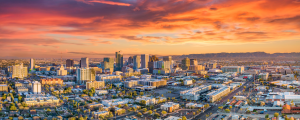Los Angeles Retail Market Report
Market Overview
The Los Angeles economy is diverse, with significant contributions from entertainment, tourism, international trade, fashion, and aerospace industries. The market’s creative workforce and entrepreneurial spirit contribute to high levels of business formation and self-employment. Sectors like transportation have seen growth, particularly in warehousing, driven by increased demands from retailers and e-commerce operations. This is largely facilitated by the bustling ports of Los Angeles and Long Beach, which handle a massive volume of containers annually. While availability rates have fluctuated, neighborhood centers are benefiting from post-pandemic shopping behavior shifts, particularly in suburban submarkets like Mid-Cities and Antelope Valley.
Market Performance
Los Angeles rents remain among the highest nationally, with a 0.1% increase in market rent over the past year and 2.2% annually over five years. Despite challenges, neighborhood centers show promise, with rent growth outpacing the market average. The construction pipeline remains relatively low, with only 1.7 million square feet under construction, representing a small fraction of the metro’s existing retail inventory. Vacancy rate stands at 5.4%. Transaction activity in the Los Angeles retail market is cooling off as investors adapt to higher interest rates, with sales volume reaching only $3.3 billion in 2023.
Single-tenant net-leased properties continue to attract high prices, exemplified by the sale of a Trader Joe’s store in Agoura Hills for $13.6 million in December 2023. While some upscale submarkets like Beverly Hills and Century City have seen lower price appreciation, overall rent growth remains positive, likely contributing to higher net operating income.
Market prices have grown annually by 3.2% over the past five years, with submarkets like the San Fernando Valley and Antelope Valley experiencing the strongest demand due to their concentration of neighborhood centers.
To read a previous Los Angeles Retail Market Report, click here.









